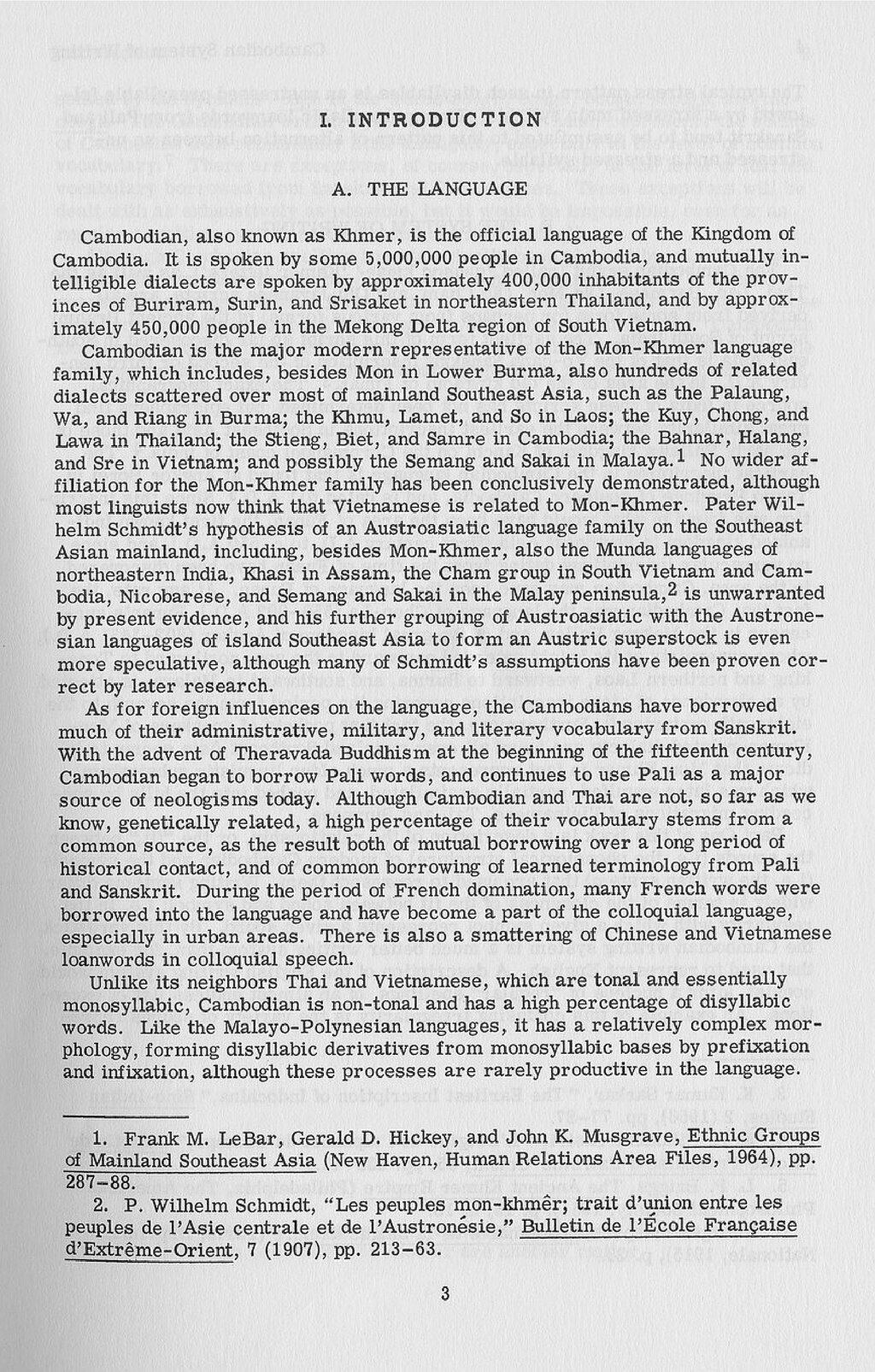I. INTRODUCTION
A. THE LANGUAGE
Cambodian, also known as Khmer, is the official language of the Kingdom of Cambodia. It is spoken by some 5,000,000 people in Cambodia, and mutually intelligible dialects are spoken by approximately 400,000 inhabitants of the provinces of Buriram, Surin, and Srisaket in northeastern Thailand, and by approximately 450,000 people in the Mekong Delta region of South Vietnam.
Cambodian is the major modern representative of the Mon-Khmer language family, which includes, besides Mon in Lower Burma, also hundreds of related dialects scattered over most of mainland Southeast Asia, such as the Palaung, Wa, and Riang in Burma; the Khmu, Lamet, and So in Laos; the Kuy, Chong, and Lawa in Thailand; the Stieng, Biet, and Samre in Cambodia; the Bahnar, Halang, and Sre in Vietnam; and possibly the Semang and Sakai in Malaya.[1] No wider affiliation for the Mon-Khmer family has been conclusively demonstrated, although most linguists now think that Vietnamese is related to Mon-Khmer. Pater Wilhelm Schmidt’s hypothesis of an Austroasiatic language family on the Southeast Asian mainland, including, besides Mon-Khmer, also the Munda languages of northeastern India, Khasi in Assam, the Cham group in South Vietnam and Cambodia, Nicobarese, and Semang and Sakai in the Malay peninsula,[2] is unwarranted by present evidence, and his further grouping of Austroasiatic with the Austronesian languages of island Southeast Asia to form an Austric superstock is even more speculative, although many of Schmidt’s assumptions have been proven correct by later research.
As for foreign influences on the language, the Cambodians have borrowed much of their administrative, military, and literary vocabulary from Sanskrit. With the advent of Theravada Buddhism at the beginning of the fifteenth century, Cambodian began to borrow Pali words, and continues to use Pali as a major source of neologisms today. Although Cambodian and Thai are not, so far as we know, genetically related, a high percentage of their vocabulary stems from a common source, as the result both of mutual borrowing over a long period of historical contact, and of common borrowing of learned terminology from Pali and Sanskrit. During the period of French domination, many French words were borrowed into the language and have become a part of the colloquial language, especially in urban areas. There is also a smattering of Chinese and Vietnamese loanwords in colloquial speech.
Unlike its neighbors Thai and Vietnamese, which are tonal and essentially monosyllabic, Cambodian is non-tonal and has a high percentage of disyllabic words. Like the Malayo-Polynesian languages, it has a relatively complex morphology, forming disyllabic derivatives from monosyllabic bases by prefixation and infixation, although these processes are rarely productive in the language.
- ↑ Frank M. LeBar, Gerald D. Hickey, and John K. Musgrave (1964). Ethnic Groups of Mainland Southeast Asia. New Haven: Human Relations Area Files. pp. 287–88.
- ↑ P. Wilhelm Schmidt (1907). "Les peuples mon-khmêr; trait d’union entre les peuples de l’Asie centrale et de l’Austronésie". Bulletin de l’École Française d’Extrême-Orient 7: 213–63.
